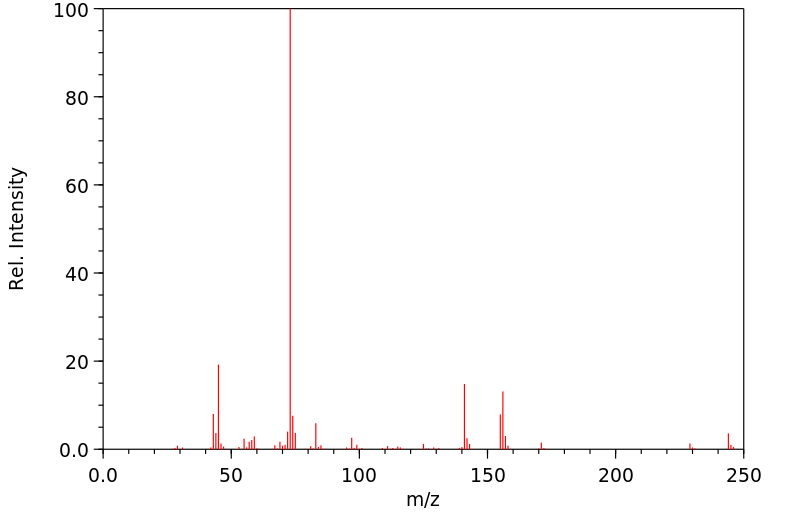[2,2-二(三甲基硅烷基)乙烯基](三甲基)硅烷 | 18938-24-4
中文名称
[2,2-二(三甲基硅烷基)乙烯基](三甲基)硅烷
中文别名
——
英文名称
tris(trimethylsilyl)ethene
英文别名
Tris(trimethylsilyl)ethen;1,2-bis(trimethylsilyl)ethenyl-trimethylsilane
CAS
18938-24-4
化学式
C11H28Si3
mdl
——
分子量
244.6
InChiKey
CUFNUQSBSOKXJH-UHFFFAOYSA-N
BEILSTEIN
——
EINECS
——
-
物化性质
-
计算性质
-
ADMET
-
安全信息
-
SDS
-
制备方法与用途
-
上下游信息
-
文献信息
-
表征谱图
-
同类化合物
-
相关功能分类
-
相关结构分类
计算性质
-
辛醇/水分配系数(LogP):4.55
-
重原子数:14
-
可旋转键数:3
-
环数:0.0
-
sp3杂化的碳原子比例:0.82
-
拓扑面积:0
-
氢给体数:0
-
氢受体数:0
安全信息
-
海关编码:2931900090
SDS
反应信息
-
作为产物:描述:trisylthioaldehyde 在 甲基锂 作用下, 以79%的产率得到[2,2-二(三甲基硅烷基)乙烯基](三甲基)硅烷参考文献:名称:First isolation of a stable aliphatic thioaldehyde, tris(trimethylsilyl)ethanethial摘要:DOI:10.1021/ja00235a046
文献信息
-
Organic synthesis with reagents derived from 3R3SiMgMe and MnCl2作者:Keigo Fugami、Jun-ichi Hibino、Shigeki Nakatsukasa、Seijiro Matsubara、Koichiro Oshima、Kiitiro Utimoto、Hitosi NozakiDOI:10.1016/s0040-4020(01)86672-2日期:1988.1R3SiMgMe and MnCl2 are disclosed. (1) The manganese species reacted with terminal acetylenes to give 1,2-disilylated 1-alkenes. Mono- and bis(trimethylsilyl) acetylenes gave tri- and tetrasilylated ethenes, respectively, in good yields. Highly strained tetrakis(trimethylsilyl) ethene has now become easily accessible by this technique. (2) The reaction of alkenyl halides, alkenyl sulfides, and enol phosphates
-
Platinum-catalyzed elimination—addition reactions of trisilylethenes作者:Toshio Suzuki、Peter Y. LoDOI:10.1016/0022-328x(91)80078-x日期:1991.1isomerization—redistributiuon reactions catalyzed by platinum. Each of them is converted into its (Z)-isomer and ethenes bearing one trimethylsilyl group and two substituted silyl groups as major products. The proposed mechanism for the reactions involves a sequence of eliminations of hydrosilanes from the ethenes and re-addition to them. Oxygen greatly affects the reaction, apparently accelerating anti-elimination
-
d-orbitaleffekte in silizium-substituierten π-elektronensystemen VI. Spektroskopische untersuchungen an alkyl- und silyläthylenen作者:Hans Bock、Hans SeidlDOI:10.1016/s0022-328x(00)88859-2日期:1968.713 alkyl- and silylethylenes have been synthesized to determine their vertical ionization energies, characteristic IR frequencies, 1H NMR signals, π → π* electronic transitions, halfwave reduction potentials and ESR spin densities of their radical anions. The result confirm d/π interactions in the ground state and d/π interactions in the excited state of silylethylene-π-electron systems. The inductive
-
New aspects of platinum-catalyzed hydrosilylation of disilylethynes作者:Toshio Suzuki、Peter Y. LoDOI:10.1016/0022-328x(90)80152-p日期:1990.7The platinum-catalyzed hydrosilylations of bis(trimethylsilyl)ethyne and 1-trimethylsilylethynyl-1,1,3,3,5,5,7,7,7-nonamethyltetrasiloxane at 130–150°C were investigated using high molecular weight organosilicon hydrides. In addition to the expected adducts, significant amount of unexpected disilylethynes and trisilylethenes were produced. It is suggested that the reaction sequence involves elimination
-
Unexpected products from the reductive trimethyl-silylation of bis(trimethylsilyl)acetylene作者:Laverne C. Quass、Robert West、G. Ronald HuskDOI:10.1016/s0022-328x(00)90593-x日期:1970.16-tris(trimethylsilyl)-2,4,7-trisilaoctane (IV). Compound III was also obtained by the reductive trimethylsilylation of tris(trimethylsilyl)ethylene. The temperature dependent proton magnetic resonance spectra and other evidence for the structures of (III) and (IV) are discussed. A mechanism for the formation of (III) and (IV) involving an intramolecular metalation competing with metalation of trimethylchlorosilane
表征谱图
-
氢谱1HNMR
-
质谱MS
-
碳谱13CNMR
-
红外IR
-
拉曼Raman
-
峰位数据
-
峰位匹配
-
表征信息
同类化合物
(2-溴乙氧基)-特丁基二甲基硅烷
鲸蜡基聚二甲基硅氧烷
骨化醇杂质DCP
马沙骨化醇中间体
马来酸双(三甲硅烷)酯
顺式-二氯二(二甲基硒醚)铂(II)
顺-N-(1-(2-乙氧基乙基)-3-甲基-4-哌啶基)-N-苯基苯酰胺
降钙素杂质13
降冰片烯基乙基三甲氧基硅烷
降冰片烯基乙基-POSS
间-氨基苯基三甲氧基硅烷
镓,二(1,1-二甲基乙基)甲基-
镁,氯[[二甲基(1-甲基乙氧基)甲硅烷基]甲基]-
锑,二溴三丁基-
铷,[三(三甲基甲硅烷基)甲基]-
铂(0)-1,3-二乙烯-1,1,3,3-四甲基二硅氧烷
钾(4-{[二甲基(2-甲基-2-丙基)硅烷基]氧基}-1-丁炔-1-基)(三氟)硼酸酯(1-)
金刚烷基乙基三氯硅烷
酰氧基丙基双封头
达格列净杂质
辛醛,8-[[(1,1-二甲基乙基)二甲基甲硅烷基]氧代]-
辛甲基-1,4-二氧杂-2,3,5,6-四硅杂环己烷
辛基铵甲烷砷酸盐
辛基衍生化硅胶(C8)ZORBAX?LP100/40C8
辛基硅三醇
辛基甲基二乙氧基硅烷
辛基三甲氧基硅烷
辛基三氯硅烷
辛基(三苯基)硅烷
辛乙基三硅氧烷
路易氏剂-3
路易氏剂-2
路易士剂
试剂Cyanomethyl[3-(trimethoxysilyl)propyl]trithiocarbonate
试剂3-[Tris(trimethylsiloxy)silyl]propylvinylcarbamate
试剂3-(Trimethoxysilyl)propylvinylcarbamate
试剂2-(Trimethylsilyl)cyclopent-2-en-1-one
试剂11-Azidoundecyltriethoxysilane
西甲硅油杂质14
衣康酸二(三甲基硅基)酯
苯胺,4-[2-(三乙氧基甲硅烷基)乙基]-
苯磺酸,羟基-,盐,单钠聚合甲醛,1,3,5-三嗪-2,4,6-三胺和脲
苯甲醇,a-[(三苯代甲硅烷基)甲基]-
苯并磷杂硅杂英,5,10-二氢-10,10-二甲基-5-苯基-
苯基二甲基氯硅烷
苯基二甲基乙氧基硅
苯基二甲基(2'-甲氧基乙氧基)硅烷
苯基乙酰氧基三甲基硅烷
苯基三辛基硅烷
苯基三甲氧基硅烷







